Mitsubishi Reports Toyota Replication
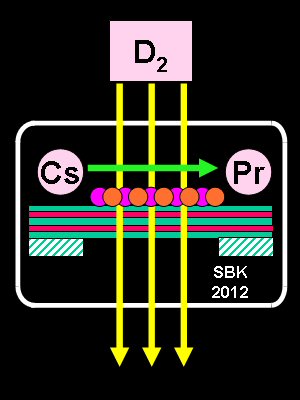
Dec. 7, 2012 – By Steven B. Krivit –
Researchers from Toyota Central Research and Development Laboratories performed an independent replication of a Mitsubishi low-energy nuclear reaction transmutation experiment, according to a physicist from Mitsubishi Heavy Industries speaking at the American Nuclear Society LENR session on Nov. 14 in San Diego, Calif.
The physicist, Yasuhiro Iwamura, told the ANS audience that the Toyota researchers confirmed that nuclear changes from one element to another took place without the use of high-energy nuclear physics. Most scientists who have not followed this field closely consider such profound claims inconceivable. Toyota used a LENR deuterium-permeation transmutation method that Iwamura invented.
Iwamura has been working with this LENR method for 14 years. He said that one of his LENR transmutations was closely but not identically replicated by Toyota. Osaka University and Iwate University previously reported similar replications.
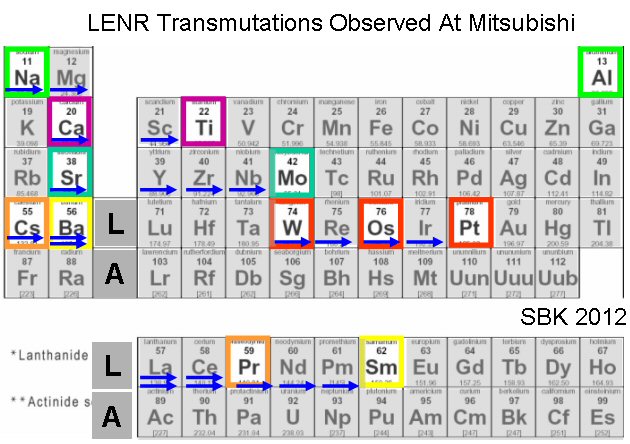
MHI LENR transmutations: Na to Al, Ca to Ti, Sr to Mo, Cs to Pr, Ba to Sm and W to Os or Pt.
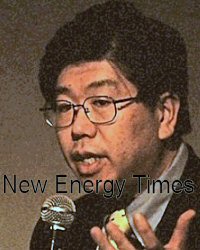
Yasuhiro Iwamura
New Energy Times explained the Iwamura deuterium-permeation experimental process in detail two years ago in this article. Iwamura has reported at least half a dozen pairs of transmutations. He finds that abundances of the target element are higher and abundances of the given element are lower after the experiments. He also has seen anomalous isotopic shifts.
Toyota Replication
The Toyota researchers replicated Iwamura’s transmutation of cesium into praseodymium. The researchers tested samples that were not used in experiments, using inductively coupled plasma mass spectrometry, and found that praseodymium exists on the surfaces of the samples as a minor trace contaminant but the amount is one order of magnitude less than the amount of post-experiment praseodymium.
The researchers also took samples that were not used in experiments and completely dissolved them to address the speculation of possible preferential migration from the bulk to the surface. In this case as well, they found that the total amounts of praseodymium in the post-experiment samples were more than one order of magnitude larger than the total amount of praseodymium trace impurities.
Toyota’s conversion rate of cesium to praseodymium was one-to-two orders of magnitude lower than that of Mitsubishi’s; however, the distinction between their tests with cesium and control tests without cesium is unambiguous.
The slide below, shown by Iwamura at ANS, shows 11 of Toyota’s replication attempts. There are three groups of experiments. In the first, the researchers used an electrolytic method to deposit cesium onto the multilayer substrates. The researchers were not able to precisely control the amount of cesium deposited using this method. Regardless, they detected a statistically significant amount of praseodymium in runs #2 and #4.
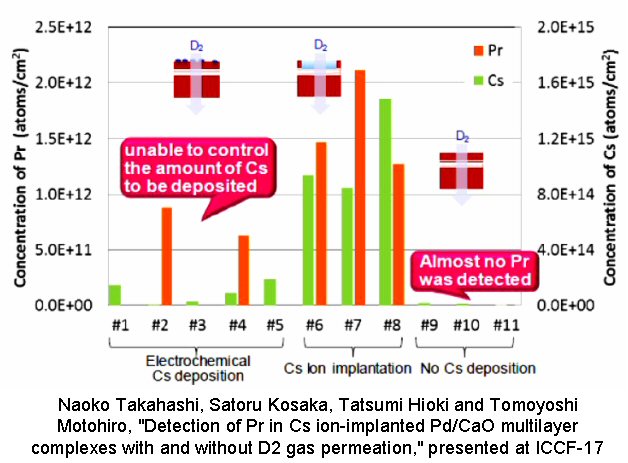
Some of Toyota’s replication attempts of the Mitsubishi LENR transmutation experiment.
In the second method, the researchers used ion implantation to deposit precise amounts of cesium into the multilayer film. In each of these runs, the researchers were able to observe the growth of praseodymium. In the third set of experiments, the researchers did not implant any cesium, and they saw no praseodymium over background.
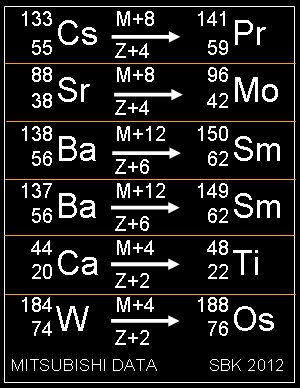
Some of the reported Mitsubishi LENR transmutations.
Summary of Mitsubishi LENR Transmutations
During the last decade, Mitsubishi has observed many pairs of LENR transmutations. The transmutations have increased the atomic number of the target elements by two, four or six protons and the atomic mass by four, eight or 12, respectively. Usually, the given elements show an equivalent decrease in mass, as well. The data are among the most fascinating in the field and may help to explain the underlying mechanisms in these unusual experiments.
Iwamura’s Proposed Mechanism
In 2002, and later in 2009, Iwamura filed U.S. patent applications for his process. In these applications, he cited a proposed mechanism based on his “Electron-Induced Nuclear Reaction” model, which he published in Fusion Technology.[1]
In these documents, he proposes a series of neutron captures followed by cascades of energetic beta-decays. For example, he discusses his transmutation of sodium into aluminum. He proposes that sodium-23 interacts with two dineutrons (a relatively new and questionable concept in physics) to form sodium-27. Sodium-27 then beta-decays to the next chemical element, magnesium-27. Magnesium-27 beta-decays to aluminum-27.

Proposed reactions as shown in Iwamura’s 2002 and 2009 U.S. patent applications. (See below for alternate reaction path.)
Iwamura’s “Electron-Induced Nuclear Reaction” model was not complete, and it didn’t explain any way to create the neutrons, but it was a logical start. He did not perform additional work on his theory. However, the Widom-Larsen theory, published in 2006, did show how neutrons could be created in LENRs.
The Widom-Larsen ultra-low-momentum neutron-catalyzed theory of LENRs presents another way to speculate on the Mitsubishi phenomena through cascades of rapid, energetic beta-decays. According to Larsen’s slide presentations, neutron captures take place in picoseconds, but the decays take much longer. That would result in the following nucleosynthetic pathway.

Alternate speculation on Mitsubishi nucleosynthetic pathway.
In the equation above, prompt gammas arising from neutron capture are not shown and are converted into infra-red by heavy electrons in condensed-matter LENR systems.
New Energy Times also asked Iwamura whether he had seen any of the intermediate elements in his transmutation sets. He said that, in most cases, he had not.
New Energy Times asked Iwamura for more details on his tungsten transmutation, specifically, whether he thought he was getting osmium as an intermediate product on the way to platinum. Iwamura was not sure, but he speculated that two reactions are taking place: W182 –> Pt190 and W186 –> Os190.
In his 2012 ANS slides and paper, Iwamura speculates on alpha-capture reactions as a possible mechanism for the transmutations. He said that his speculation about alpha-capture reactions was based purely on his observation of the phenomena and that he does not claim to be a theoretician. He thought that perhaps deuterium nuclei first become 4He nuclei, then the 4He nuclei overcome the Coulomb barrier and are captured by the target element. However, alpha-captures are fusion reactions that normally take place in stars under extreme temperatures.
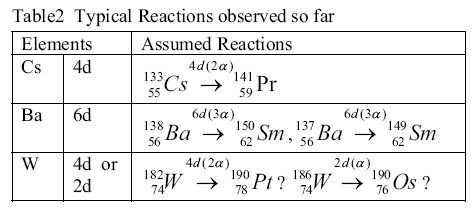
Speculative reactions as shown in Iwamura’s 2012 ANS paper
In Iwamura’s ANS paper, he writes, “There are no established theories that can explain the experimental results without any assumptions, although some attractive models and theories have been proposed [Takahashi] and [Widom-Larsen].”
Akito Takahashi began work in the field as an experimentalist 22 years ago with a unique electrolytic method and soon developed a “cold fusion” theory. Despite our best effort to learn more about Takahashi’s theory from him, our Web page about his theory is sparse. The Widom-Larsen theory, however, has a lot going for it.
Future Progress and Applications
Iwamura said that Mitsubishi is considering his research for three potential applications. The first is for a transmutation facility for radioactive cesium. Mitsubishi is a manufacturer of fission reactors, and cesium-137 is a normal by-product. The second application is the production of rare metals, such as platinum, from abundant metals, such as tungsten. The third application is electrical power generation from excess heat.
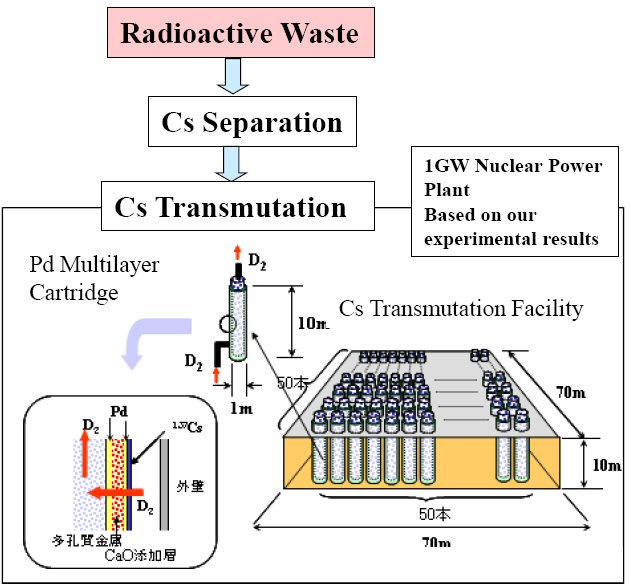 Mitsubishi Concept of LENR Transmutation Facility
Mitsubishi Concept of LENR Transmutation Facility
New Energy Times asked Iwamura whether he had attempted to transmute radioactive cesium-137. He said only that his group performed preliminary experiments. A reporter from Nuclear News asked Iwamura what the likely end product of such a LENR transmutation reaction might be. Iwamura said it would probably be europium.
A member of the audience asked Iwamura whether other Japanese companies besides Toyota and Mitsubishi are working on LENR. Iwamura said yes but they were not disclosing it.
Resources:
Iwamura’s ANS Slides
Iwamura’s ANS Video
Iwamura’s ANS Paper
References
Iwamura, Y., Itoh, T., Gotoh, N., and Toyoda, I. “Detection Of Anomalous Elements, X-Ray, And Excess Heat In A D2-Pd System And Its Interpretation By The Electron-Induced Nuclear Reaction Model,” Fusion Technology, 33(4), p. 476-492 (July 1998)
Questions? Comments? Submit a Letter to the Editor.

